From the right tools and equipment to preparing the printed object and post-processing methods, we will guide you step-by-step through the process.
Get ready to master the art of support removal and achieve flawless results in your large scale 3D printing projects.
Support Removal Tools and Equipment
To remove supports from your large-scale 3D printed objects, you can use various tools and equipment specifically designed for support removal.
Ensuring support removal safety is crucial to prevent any accidents or damage to your objects. When selecting support removal tools, consider factors such as the type of material used and the complexity of the support structures.
Proper maintenance of support removal equipment is necessary to ensure their longevity and effectiveness. Regularly clean and inspect the tools to remove any debris or wear and tear.
To optimize your support removal workflow and save time, consider using time-saving techniques such as pre-soaking your prints in a support removal solution or using specialized support removal pliers. It is essential to follow the manufacturer’s instructions and guidelines when using these tools and equipment.
Always wear appropriate personal protective equipment, such as gloves and safety glasses, to protect yourself during the support removal process.
By implementing these techniques and selecting the right tools, you can efficiently remove supports from your large-scale 3D printed objects while ensuring safety and saving time.
Preparing the Printed Object for Support Removal
When preparing the printed object for support removal, it’s important to ensure that the supports are properly attached. The success of the support removal process depends on several factors that need to be considered:
Support adhesion
The supports should be securely attached to the printed object to provide stability during the printing process. Proper adhesion prevents the supports from detaching prematurely and causing damage to the printed object.
Material compatibility
The material used for the supports should be compatible with the material of the printed object. Different materials have different properties, such as flexibility and strength, which can affect the ease of support removal. It is important to choose materials that can be easily removed without leaving any residue or marks on the printed object.
Support structure optimization
The design of the support structure plays a crucial role in support removal. Optimizing the support structure involves determining the right placement and orientation of the supports to minimize the contact area with the printed object. This reduces the effort required for support removal and minimizes the risk of damaging the printed object.
Surface finishing
Surface finishing also plays a role in the support removal process. A smooth surface finish on the printed object makes it easier to remove the supports without leaving any marks or scratches.
Support removal time
This refers to the amount of time required to remove the supports from the printed object. Longer support removal times can impact productivity and efficiency, so it is important to choose support removal techniques that are time-effective.
Techniques for Removing Supports From Large-Scale 3D Printed Objects
If you’re working with bigger 3D printed items, you’ll want to know effective methods for removing the supports. Support removal optimization is crucial to ensure a successful post-processing stage.
Here are some time-saving techniques to consider.
For complex geometries, utilizing support structures that are easy to remove is essential. Designing custom supports that follow the shape of your object can make removal more efficient. Additionally, using soluble support materials can eliminate the need for physical removal altogether.
When dealing with delicate prints, it’s important to approach support removal with caution. Gentle techniques, such as using fine-tipped tools or dissolving supports in water, can help preserve the integrity of the print. Avoid applying excessive force that could damage the object.
High resolution prints require careful support removal to maintain the fine details. Gradual and controlled removal techniques, such as sanding or using chemical solvents, can help prevent any accidental damage to the print. Paying close attention to each layer and removing supports layer by layer can ensure a clean finish.
Post-Processing Methods for Support Removal
For optimal results, it’s important to utilize post-processing methods that effectively remove supports from your 3D printed objects. Here are three advanced techniques to consider:
Chemical Dissolution
This method involves using chemical agents to dissolve the support structures. By immersing the printed object in a suitable solvent bath, the supports can be selectively dissolved while leaving the main object intact. This technique is particularly useful for complex geometries and delicate prints.
Heat Treatment
Applying heat to the printed object can help weaken the bond between the support structures and the main object. This allows for easier removal of the supports without causing damage to the print. Heat treatment can be done using a heat gun or by placing the object in an oven at a controlled temperature.
Mechanical Separation
This technique involves physically separating the supports from the main object using tools such as pliers or tweezers. Care must be taken to avoid damaging the print during this process. It is important to have a good understanding of the material properties and the design of the supports to ensure successful removal.
In addition to these techniques, other methods such as solvent baths and ultrasonic cleaning can also be used to further enhance the support removal process. Remember to choose the method that best suits your specific needs and take appropriate safety precautions when handling chemicals or applying heat.
Best Practices for Support Removal on Large-Scale Prints
To effectively remove supports from your large-scale prints, it’s important to follow these best practices. Support removal safety should be a top priority to prevent any injuries or accidents.
Always wear appropriate personal protective equipment (PPE) such as gloves and eye protection when handling sharp tools or chemicals. Additionally, ensure that the work area is well-ventilated to minimize exposure to fumes.
When it comes to support removal time-saving techniques, consider using automated support removal systems. These systems can significantly reduce the time and effort required for manual support removal. They utilize features such as high-pressure water jets or mechanical arms to efficiently remove supports from the 3D printed objects.
To achieve a smooth surface finish after support removal, it’s crucial to carefully clean and sand the printed object. Use a combination of cleaning agents and brushes to remove any residue left behind by the supports. Then, use sandpaper with progressively finer grits to polish the surface until it reaches the desired smoothness.
Support removal automation can also be a cost-effective solution. By investing in automated support removal systems, you can reduce labor costs and increase productivity. Conduct a support removal cost analysis to determine the potential savings and return on investment.
Troubleshooting Common Challenges in Support Removal
One common challenge in support removal is when the supports are difficult to reach or access. This can make the process of removing them more time-consuming and tedious. However, there are techniques and tips that can help you troubleshoot these challenges and ensure efficient support removal.
Here are three techniques to overcome support removal challenges:
- Invest in tools specifically designed for support removal, such as angled tweezers or support removal pliers. These tools can help you reach and remove supports in tight or hard-to-reach areas more easily.
- Before printing, adjust the support settings in your 3D printing software to make them easier to remove. You can increase the support density in areas that require more stability, while reducing it in areas that are easier to access. This way, you can strike a balance between support removal difficulty and print quality.
- After printing, consider using post-processing techniques like sanding or filing to smooth out any rough edges left by the support removal process. This can help improve the overall surface finish of your 3D printed object.
Advanced Support Removal Techniques and Tips
If you’re struggling with removing supports from your 3D prints, there are innovative techniques and helpful tips available to make the process easier. Advanced support removal methods can maximize efficiency, minimize damage, reduce post-processing time, and optimize support placement.
- One effective technique is using heat to soften the support material. By applying heat to the supports, they become more pliable and easier to remove. This can be done using a heat gun or a heated air blower. Be cautious not to overheat the printed object, as it can cause warping or deformation.
- Another method is using water-soluble support materials. These materials dissolve in water, eliminating the need for physical removal. Simply submerge the printed object in water and the supports will dissolve over time. This method is particularly useful for complex or intricate designs where physical removal is challenging.
- Additionally, utilizing support removal tools such as needle-nose pliers or tweezers can provide better control and precision when removing supports. These tools allow you to reach tight spaces and remove supports without damaging the printed object.
- To further optimize support removal, carefully consider the placement of supports during the printing process. By strategically placing supports in areas that are less visible or require less post-processing, you can minimize the amount of support material that needs to be removed.



